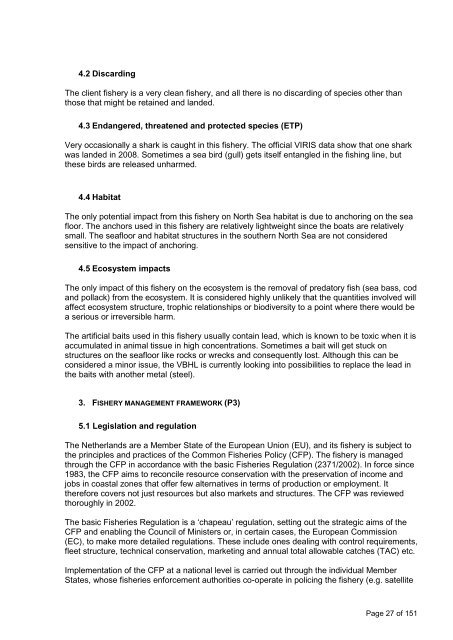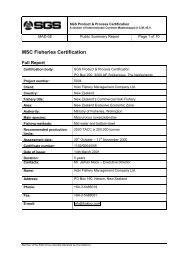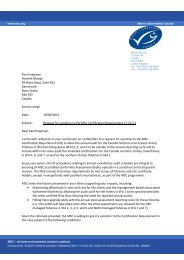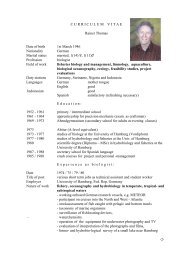SGS Product & Process Certification - Marine Stewardship Council
SGS Product & Process Certification - Marine Stewardship Council
SGS Product & Process Certification - Marine Stewardship Council
Create successful ePaper yourself
Turn your PDF publications into a flip-book with our unique Google optimized e-Paper software.
4.2 Discarding<br />
The client fishery is a very clean fishery, and all there is no discarding of species other than<br />
those that might be retained and landed.<br />
4.3 Endangered, threatened and protected species (ETP)<br />
Very occasionally a shark is caught in this fishery. The official VIRIS data show that one shark<br />
was landed in 2008. Sometimes a sea bird (gull) gets itself entangled in the fishing line, but<br />
these birds are released unharmed.<br />
4.4 Habitat<br />
The only potential impact from this fishery on North Sea habitat is due to anchoring on the sea<br />
floor. The anchors used in this fishery are relatively lightweight since the boats are relatively<br />
small. The seafloor and habitat structures in the southern North Sea are not considered<br />
sensitive to the impact of anchoring.<br />
4.5 Ecosystem impacts<br />
The only impact of this fishery on the ecosystem is the removal of predatory fish (sea bass, cod<br />
and pollack) from the ecosystem. It is considered highly unlikely that the quantities involved will<br />
affect ecosystem structure, trophic relationships or biodiversity to a point where there would be<br />
a serious or irreversible harm.<br />
The artificial baits used in this fishery usually contain lead, which is known to be toxic when it is<br />
accumulated in animal tissue in high concentrations. Sometimes a bait will get stuck on<br />
structures on the seafloor like rocks or wrecks and consequently lost. Although this can be<br />
considered a minor issue, the VBHL is currently looking into possibilities to replace the lead in<br />
the baits with another metal (steel).<br />
3. FISHERY MANAGEMENT FRAMEWORK (P3)<br />
5.1 Legislation and regulation<br />
The Netherlands are a Member State of the European Union (EU), and its fishery is subject to<br />
the principles and practices of the Common Fisheries Policy (CFP). The fishery is managed<br />
through the CFP in accordance with the basic Fisheries Regulation (2371/2002). In force since<br />
1983, the CFP aims to reconcile resource conservation with the preservation of income and<br />
jobs in coastal zones that offer few alternatives in terms of production or employment. It<br />
therefore covers not just resources but also markets and structures. The CFP was reviewed<br />
thoroughly in 2002.<br />
The basic Fisheries Regulation is a ‗chapeau‘ regulation, setting out the strategic aims of the<br />
CFP and enabling the <strong>Council</strong> of Ministers or, in certain cases, the European Commission<br />
(EC), to make more detailed regulations. These include ones dealing with control requirements,<br />
fleet structure, technical conservation, marketing and annual total allowable catches (TAC) etc.<br />
Implementation of the CFP at a national level is carried out through the individual Member<br />
States, whose fisheries enforcement authorities co-operate in policing the fishery (e.g. satellite<br />
Page 27 of 151





